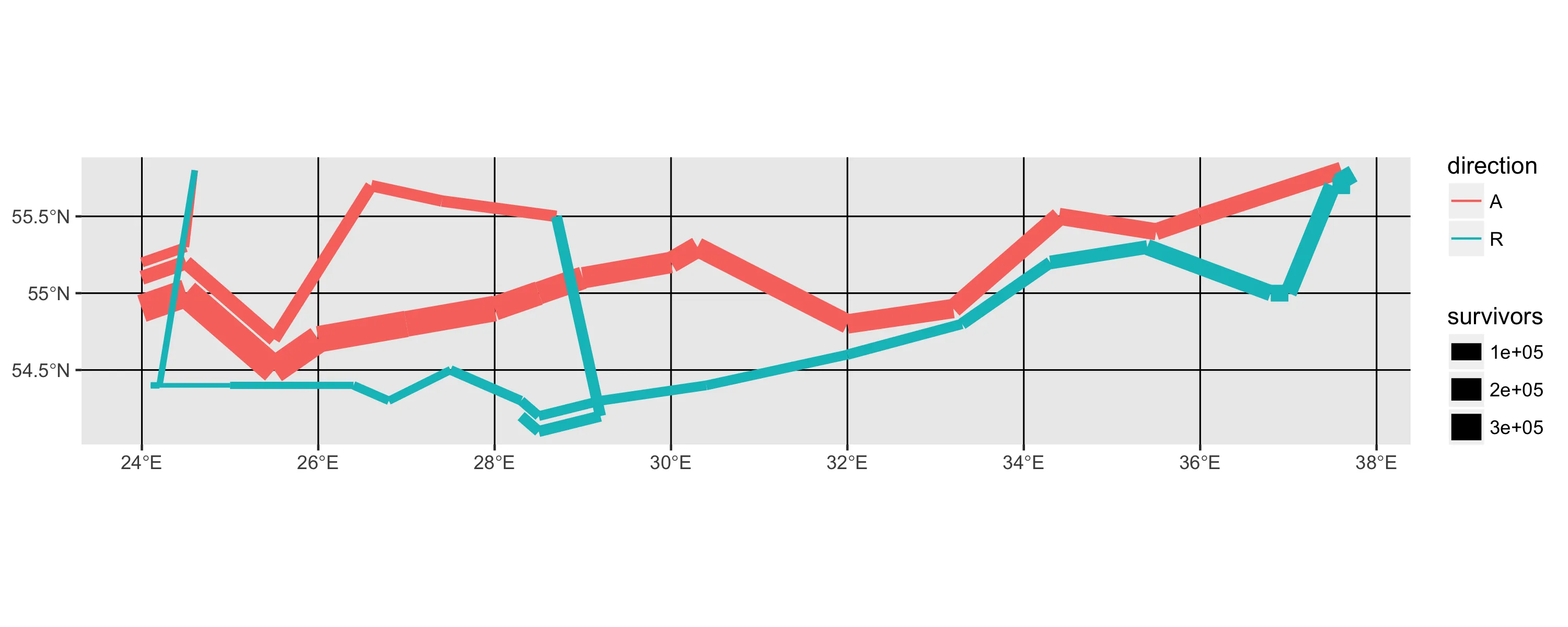新近推出的 R 包 sf 使得在 R 中处理地理数据变得非常容易,ggplot2 的开发版本中也新增了一个 geom_sf() 图层,用于绘制 sf 风格的地理数据。
在 sf 数据处理范例中,是否可以将 ggplot 美学映射到 LINESTRING 几何图形上?
例如,在标准 ggplot 中,可以使用此数据通过调整军队路径的大小来重现 Minard 在 1812 年拿破仑大军的幸存者的著名图表。
如果我们使用
ggplot可以绘制这六条连接线并正确着色。
在 sf 数据处理范例中,是否可以将 ggplot 美学映射到 LINESTRING 几何图形上?
例如,在标准 ggplot 中,可以使用此数据通过调整军队路径的大小来重现 Minard 在 1812 年拿破仑大军的幸存者的著名图表。
# Install the dev version of ggplot2 for geom_sf()
# devtools::install_github("tidyverse/ggplot2")
library(tidyverse)
troops <- read_csv("https://gist.githubusercontent.com/andrewheiss/69b9dffb7cca392eb7f9bdf56789140f/raw/3e2a48635ae44837955765b5e7747c429b0b5d71/troops.csv")
ggplot(troops) +
geom_path(aes(x = long, y = lat, color = direction,
group = group, size = survivors),
lineend = "round")

geometry列,将这些部队数据作为sf对象来处理,如下所示:library(sf)
#> Linking to GEOS 3.6.1, GDAL 2.1.3, proj.4 4.9.3
troops_with_geometry <- troops %>%
st_as_sf(coords = c("long", "lat"))
head(troops_with_geometry)
#> Simple feature collection with 6 features and 3 fields
#> geometry type: POINT
#> dimension: XY
#> bbox: xmin: 24 ymin: 54.5 xmax: 28 ymax: 55
#> epsg (SRID): NA
#> proj4string: NA
#> # A tibble: 6 x 4
#> survivors direction group geometry
#> <int> <chr> <int> <simple_feature>
#> 1 340000 A 1 <POINT (24 54.9)>
#> 2 340000 A 1 <POINT (24.5 55)>
#> 3 340000 A 1 <POINT (25.5 ...>
#> 4 320000 A 1 <POINT (26 54.7)>
#> 5 300000 A 1 <POINT (27 54.8)>
#> 6 280000 A 1 <POINT (28 54.9)>
如果我们使用
geom_sf绘制,ggplot将使用点:ggplot(troops_with_geometry) +
geom_sf(aes(color = direction, group = group))

troops_lines <- troops_with_geometry %>%
group_by(direction, group) %>%
summarize() %>%
st_cast("LINESTRING")
head(troops_lines)
#> Simple feature collection with 6 features and 2 fields
#> geometry type: LINESTRING
#> dimension: XY
#> bbox: xmin: 24 ymin: 54.1 xmax: 37.7 ymax: 55.8
#> epsg (SRID): NA
#> proj4string: NA
#> direction group geometry
#> 1 A 1 LINESTRING (24 54.9, 24.5 5...
#> 2 A 2 LINESTRING (24 55.1, 24.5 5...
#> 3 A 3 LINESTRING (24 55.2, 24.5 5...
#> 4 R 1 LINESTRING (24.1 54.4, 24.2...
#> 5 R 2 LINESTRING (28.3 54.2, 28.5...
#> 6 R 3 LINESTRING (24.1 54.4, 24.2...
ggplot可以绘制这六条连接线并正确着色。
ggplot(troops_lines) +
geom_sf(aes(color = direction, group = group))

sf的LINESTRING数据相关联?换句话说,是否有一种方法使用geom_sf()和sf地理数据处理范例重新创建ggplot(...) + geom_path(aes(x = long, y = lat, size = something))?
geom_sf似乎只在ggplot2的开发版本中可用(https://github.com/ropensci/seaaroundus/issues/24)。在我复制之前,我不得不从GitHub安装(`devtools::install_github("tidyverse/ggplot2")`)。 - mkearney